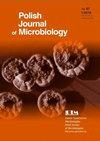癌症及良性乳腺病变患者肠道微生物群分析
IF 1.6
4区 生物学
Q4 MICROBIOLOGY
引用次数: 6
摘要
摘要癌症(BC)和良性乳腺病变(BBL)是全球女性的常见疾病。肠道微生物群在调节乳腺疾病的形成、进展和治疗反应方面发挥着至关重要的作用。因此,我们探索了BC和BBL患者肠道菌群的结构和功能。本研究共纳入66名受试者。26名受试者患有BC,20名受试人患有BBL,20名与健康对照组匹配。采用高通量16S核糖体RNA(16SrRNA)基因测序技术测定微生物群落结构。与健康个体相比,BC患者的α多样性指数显著较低(Sobs指数,p=0.019;Chao1指数,p=0.033)。BBL患者的Sobs和Chao1指标也低于健康个体,无统计学意义(分别为p=0.279,p=0.314)。未加权和加权的UniFrac分析均显示,三组之间的β多样性差异显著(分别为p=3.376e–14,p<0.001)。与健康个体相比,BC患者的卟啉单胞菌和嗜酸乳杆菌水平更高(分别为p=0.004和p=0.007),而良性乳腺病变组的大肠杆菌和乳杆菌更富集(分别为p<0.001和p=0.011)。我们的研究表明,BC和BBL患者的肠道微生物群可能发生显著变化。这些发现有助于阐明肠道菌群在BC和BBL患者中的作用。本文章由计算机程序翻译,如有差异,请以英文原文为准。
Analysis of Gut Microbiota in Patients with Breast Cancer and Benign Breast Lesions
Abstract Breast cancer (BC) and benign breast lesions (BBLs) are common diseases in women worldwide. The gut microbiota plays a vital role in regulating breast diseases’ formation, progression, and therapy response. Hence, we explored the structure and function of gut microflora in patients with BC and BBLs. A cohort of 66 subjects was enrolled in the study. Twenty-six subjects had BC, 20 subjects had BBLs, and 20 matched healthy controls. High throughput 16S ribosomal RNA (16S rRNA) gene sequencing technology was used to determine the microbial community structure. Compared with healthy individuals, BC patients had significantly lower alpha diversity indices (Sobs index, p = 0.019; Chao1 index, p = 0.033). Sobs and Chao1 indices were also lower in patients with BBLs than healthy individuals, without statistical significance (p = 0.279, p = 0.314, respectively). Both unweighted and weighted UniFrac analysis showed that beta diversity differed significantly among the three groups (p = 3.376e–14, p < 0.001, respectively). Compared with healthy individuals, the levels of Porphyromonas and Peptoniphilus were higher in BC patients (p = 0.004, p = 0.007, respectively), whereas Escherichia and Lactobacillus were more enriched in the benign breast lesion group (p < 0.001, p = 0.011, respectively). Our study indicates that patients with BC and BBLs may undergo significant changes in intestinal microbiota. These findings can help elucidate the role of intestinal flora in BC and BBLs patients.
求助全文
通过发布文献求助,成功后即可免费获取论文全文。
去求助
来源期刊

Polish Journal of Microbiology
MICROBIOLOGY-
CiteScore
3.70
自引率
4.80%
发文量
41
审稿时长
2 months
期刊介绍:
Polish Journal of Microbiology (PJM) publishes original research articles describing various aspects of basic and applied microbiological research. We are especially interested in articles regarding
- basic biological properties of bacteria and archaea, viruses, and simple
- eukaryotic microorganisms
- genetics and molecular biology
- microbial ecology
- medical bacteriology and public health
- food microbiology
- industrial microbiology
- bacterial biotechnology
 求助内容:
求助内容: 应助结果提醒方式:
应助结果提醒方式:


